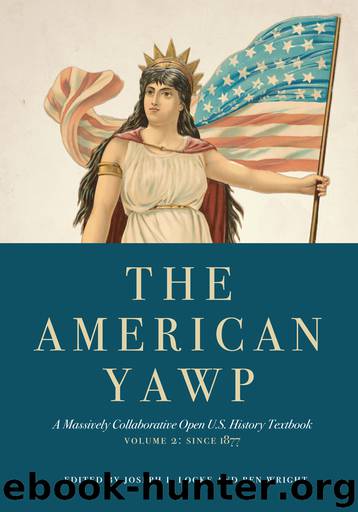The American Yawp by Joseph L. Locke;Ben Wright;

Author:Joseph L. Locke;Ben Wright; [Locke, Joseph L.]
Language: eng
Format: epub
Publisher: Stanford University Press
Published: 2018-03-11T16:00:00+00:00
24
World War II
American soldiers recover the dead on Omaha Beach in 1944. Library of Congress.
I. Introduction
The 1930s and 1940s were trying times. A global economic crisis gave way to a global war that became the deadliest and most destructive in human history. Perhaps eighty million individuals lost their lives during World War II. The war saw industrialized genocide and nearly threatened the eradication of an entire people. It also unleashed the most fearsome technology ever used in war. And when it ended, the United States found itself alone as the world’s greatest superpower. Armed with the world’s greatest economy, it looked forward to the fruits of a prosperous consumers’ economy. But the war raised as many questions as it would settle and unleashed new social forces at home and abroad that confronted generations of Americans to come.
II. The Origins of the Pacific War
Although the United States joined the war in 1941, two years after Europe exploded into conflict in 1939, the path to the Japanese bombing of Pearl Harbor, the surprise attack that threw the United States headlong into war, began much earlier. For the Empire of Japan, the war had begun a decade before Pearl Harbor.
On September 18, 1931, a small explosion tore up railroad tracks controlled by the Japanese-owned South Manchuria Railway near the city of Shenyang (Mukden) in the Chinese province of Manchuria. The railway company condemned the bombing as the work of anti-Japanese Chinese dissidents. Evidence, though, suggests that the initial explosion was neither an act of Chinese anti-Japanese sentiment nor an accident but an elaborate ruse planned by the Japanese to provide a basis for invasion. In response, the privately operated Japanese Guandong (Kwangtung) army began shelling the Shenyang garrison the next day, and the garrison fell before nightfall. Hungry for Chinese territory and witnessing the weakness and disorganization of Chinese forces, but under the pretense of protecting Japanese citizens and investments, the Japanese Imperial Army ordered a full-scale invasion of Manchuria. The invasion was swift. Without a centralized Chinese army, the Japanese quickly defeated isolated Chinese warlords and by the end of February 1932, all of Manchuria was firmly under Japanese control. Japan established the nation of Manchukuo out of the former province of Manchuria.1
This seemingly small skirmish—known by the Chinese as the September 18 Incident and the Japanese as the Manchurian Incident—sparked a war that would last thirteen years and claim the lives of over thirty-five million people. Comprehending Japanese motivations for attacking China and the grueling stalemate of the ensuing war are crucial for understanding Japan’s seemingly unprovoked attack on Pearl Harbor, Hawaii, on December 7, 1941, and, therefore, for understanding the involvement of the United States in World War II as well.
Despite their rapid advance into Manchuria, the Japanese put off the invasion of China for nearly three years. Japan occupied a precarious domestic and international position after the September 18 Incident. At home, Japan was riven by political factionalism due to its stagnating economy. Leaders were torn as to whether
Download
This site does not store any files on its server. We only index and link to content provided by other sites. Please contact the content providers to delete copyright contents if any and email us, we'll remove relevant links or contents immediately.
| Africa | Americas |
| Arctic & Antarctica | Asia |
| Australia & Oceania | Europe |
| Middle East | Russia |
| United States | World |
| Ancient Civilizations | Military |
| Historical Study & Educational Resources |
In Cold Blood by Truman Capote(3141)
Steve Jobs by Walter Isaacson(2766)
The Innovators: How a Group of Hackers, Geniuses, and Geeks Created the Digital Revolution by Walter Isaacson(2512)
All the President's Men by Carl Bernstein & Bob Woodward(2267)
Lonely Planet New York City by Lonely Planet(2108)
The Room Where It Happened by John Bolton;(2034)
And the Band Played On by Randy Shilts(2020)
The Murder of Marilyn Monroe by Jay Margolis(1984)
The Poisoner's Handbook by Deborah Blum(1984)
The Innovators by Walter Isaacson(1974)
Lincoln by David Herbert Donald(1874)
A Colony in a Nation by Chris Hayes(1797)
Under the Banner of Heaven: A Story of Violent Faith by Jon Krakauer(1687)
Amelia Earhart by Doris L. Rich(1588)
The Unsettlers by Mark Sundeen(1586)
Birdmen by Lawrence Goldstone(1536)
Dirt by Bill Buford(1523)
Zeitoun by Dave Eggers(1519)
Decision Points by George W. Bush(1466)
